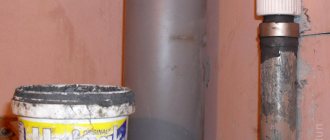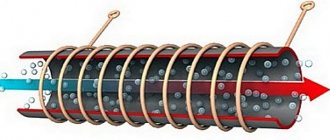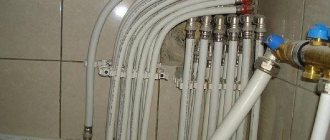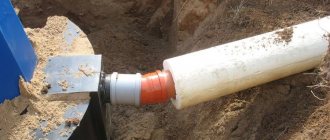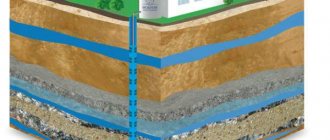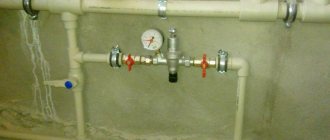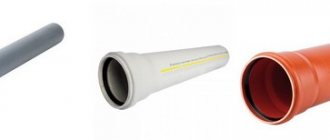MesterulManole
8760 0 0
MesterulManole July 29, 2016Specialization: many years of experience in finishing works of residential and office premises, dachas, country cottages, etc. Hobby: cycling in all its forms
Foamed polyethylene and mineral wool - excellent insulation of the heating main in the attic
Hello. Today I want to talk about how to insulate heating pipes inside and outside construction sites with my own hands . The topic is of considerable interest, since proper thermal insulation can reduce the level of heat loss when transporting coolant from the thermogenerator to the heating device. I hope you find the instructions in this article interesting and useful.
Why do you need to insulate heating pipes?
Typically, cottage owners insulate only those heating pipelines that are located outside the home. There, heat losses are most likely and large-scale. It’s not for nothing that all city heating mains are so carefully insulated. You also need to choose the heating pipes themselves very carefully.
Energy workers have already learned to count their money. However, the pipes of the heating system in the basement or boiler room should also be insulated. Heating such non-residential premises in a house is a waste of money.
There are five good reasons to cover heating pipes with a heat insulator:
- Protection of coolant from freezing.
- Prevents condensation.
- Reduced heat loss.
- Extending the “life” of boiler equipment and pipelines.
- Possibility of laying external sections of the heating system in the ground above its freezing point.
Pipes are insulated in the basement, attic, boiler room and outdoor areas. It is not worth installing insulation on risers inside the house in living rooms. If you do this, the heat will still enter the room, but through the radiator. There is no point in such actions. Money will be spent on a heat insulator, but it will be of no use.
When the coolant moves through insulated pipelines, it does not waste thermal energy. All the heat goes to heating the necessary rooms. At the same time, the boiler and pumping equipment in the boiler room do not have to operate at maximum settings in order to maintain a comfortable temperature in the rooms.
Another couple of disadvantages of heating pipes without insulation are condensation and freezing. In operating mode, when a coolant circulates through the system, most often heated water, there are no problems with its freezing inside and condensation outside. But during accidents on the heating network, the pipelines begin to “get wet” and then freeze.
Thermal insulation material in such a situation provides several additional hours, during which the coolant cools down, but not so quickly.
In general, insulation of heat supply pipes is carried out:
- when laying heating system communications outdoors;
- on sections of pipelines located in unheated basements and attics;
- when installing heating mains and branches from them onto risers in the basements of apartment buildings.
Insulated pipes provide warm batteries while reducing energy costs. Here it is better to spend money on thermal insulation materials rather than pay huge heating bills. It is always more effective to insulate than to spend money on fuel for a stove or boiler.
Conclusions and useful video on the topic
When choosing insulation for heating system pipelines, it is necessary to take into account several factors. To make it easier for you to understand this issue, we have made a selection of video materials. The above reviews and comparisons will certainly help you navigate the selection of heat insulators for pipes.
Insulation of the street pipeline from the boiler room to the house:
Review and installation rules for Energoflex insulation tube:
Technology of pipe insulation with foamed foam insulation:
It is not difficult to insulate heating pipelines; you just need to choose the right insulating material. For heating mains in the ground, it is better to prefer moisture-resistant and rigid insulation with an outer shell of steel, and for areas in the attic it is worth taking lightweight mineral wool.
All of them allow you to reduce the cost of heating your home and increase the efficiency of the entire heating system. It is only necessary to choose their thickness correctly, guided by SP 41-103-2000.
If you have any questions or want to supplement the material with valuable information on the topic, please leave comments under our article.
Insulation of heating pipes located in the area between the boiler room and the room is a necessary measure, as it allows you to maintain the temperature of the coolant. If this is not done, heat loss can be up to 20 percent. In this article we will look at how and with what insulation of heating pipes is carried out on the street.
A few words about current insulation methods
Insulated heating pipes are used if the route runs outside a construction site or through outbuildings, attics, basements and other non-residential premises. There is no need to insulate pipes in a living room, since the pipeline releases heat into the environment and acts as a heating radiator.
The photo shows a polyurethane foam shell with a reflective foil surface
At the moment, there are many varieties of thermal insulation materials and methods of their use. Pipelines, depending on their configuration and location, are insulated with expanded polystyrene, foamed polyethylene, foam rubber, mineral wool, foil insulation, etc.
Current methods of pipeline insulation are distinguished by such characteristics as the thermal conductivity of the finished result, the temperature range at which long-term operation of the insulation is possible and, of course, price.
Unfortunately, not all methods of insulating pipelines can be done with your own hands. Therefore, in my review I will talk about those technologies that I myself have encountered and the results of which I was pleased with.
So what will we look at in this article?
- Application of liquid insulating compounds;
- Application of polyurethane foam;
- Application of mineral wool;
- Application of insulating shell.
Application of coating liquid insulation on heating mains
Heating main covered with coating insulation based on perlite
The easiest way to insulate heating pipes in the basement, attic and outbuildings is done using liquid coatings such as “ARMOR CLASSIC” (ultra-thin thermal insulation).
The product is intended for application to polymer and metal surfaces at an ambient temperature of at least +7°C. Storage of the material is allowed only at positive temperatures. Operation of the material is allowed in a temperature range from +200°C to –60°C.
According to the manufacturer, the service life of the insulation is at least 15 years.
Standard five-liter packaging of “ARMOR CLASSIC”
Instructions for insulating pipelines are given in the following diagram.
Coating insulation application technology
Let's consider the main stages of working with liquid insulation in more detail:
- We prepare the surface, namely, we remove crumbling rust, dust and dirt from the material, and then wipe it with a rag soaked in thinner;
- While the surface is drying, prepare the material - open the jar and mix the contents;
Liquid insulation is used with the consistency of thick sour cream, so diluting the product with water to thin it is not recommended.
- We apply liquid thermal insulation with a regular brush over the entire surface in 2-3 layers, with a break for each previous layer to dry.
The applied layer does not look particularly neat, but it copes with the task perfectly.
Explanations for installation work:
- Despite the fact that the product is not toxic, we use protective gloves and goggles when working with it;
- We work in good lighting so that when covering the working surface there are no unpainted areas left;
- We do not paint fittings and moving areas of shut-off valves, since when liquid thermal insulation dries, it forms a dense crust, which will subsequently be difficult to remove.
How to thermally insulate a route using polyurethane foam
In one of the previous articles, I talked about how polyurethane foam is sprayed. PPU is a universal material that can be applied to various surfaces, including heating pipes.
The method I want to talk about next is one of the options for using rigid foam.
To complete the planned work you will need:
- installation for spraying polyurethane foam;
- components for producing foam;
- roofing felt and soft aluminum wire;
- plywood for cutting stiffeners.
Who should pay for replacing pipes in the basement - Pravoved.RU
Hello, I live on the first floor, the apartment is divided into three rooms, a hot water pipe in our basement burst (that is, there is no water only in our apartment, there is water in the whole house), the management company says that the residents must replace it themselves. The question is, should we pay money to replace the pipe, or should the management company do it?
Victoria Dymova
Support employee Pravoved.ru
Similar questions
- After replacing the pipes of the in-house heating system, who should eliminate the consequences (if the wallpaper was damaged during a gas weld)? 23 August 2021, 14:56, question No. 1354083 5 answers
- Replacing pipes and faucets in a communal apartment June 14, 2015, 20:38, question No. 871057 2 answers
- At whose expense should it be necessary to replace the pipe from the central water supply to the water pump in the private sector? 28 July 2021, 13:34, question No. 1708933 1 answer
- Who should pay for heating pipe repairs? February 10, 2021, 21:20, question No. 1534698 1 answer
- Should we pay to replace the pipe or should the housing department replace it for free? 16 July 2021, 13:56, question No. 1316494 1 answer
Heating pipe insulation technology
The choice of pipe thermal insulation and the method of its installation are influenced by the location of the pipeline.
Insulation of heating pipes on the street
External thermal insulation of pipes is the most difficult method of insulation, since in the open air it is not only the pipes that need protection, but also the insulation itself. For outdoor installation, non-hygroscopic materials or other materials are used, but reliably protected from moisture by a film or casing.
In addition, it is advisable to use the densest and thickest insulation outdoors. Another requirement is the use of a material that is resistant to ultraviolet radiation, bad weather and mechanical damage.
Insulation of heating pipes in an unheated room
Basement, cold attic, boiler room - a feature of such rooms is the absence of heating radiators. But since the pipes are filled with coolant and are located in an environment with minimal humidity, there are no special requirements for either the thermal insulation material or its thickness.
Thermal insulation of heating pipes in an unheated (cold) room
Insulation of heating pipes underground
The specificity of installing heating pipes underground is that they must be laid below the freezing level of the soil, which is a depth of one and a half to two meters. If you do not adhere to this requirement, the coolant will cool greatly while it passes through the heating main located in the ground. In order to reduce heat loss, you need to take care of high-quality insulation of the underground pipeline.
Experts say that the optimal solution in this case would be to use a cable pipe heating system. But due to the high cost, users prefer enhanced thermal insulation of heating pipes.
Good insulation of underground heating pipes requires the following requirements:
- insulation of insulation from moisture in the soil;
- eliminating the possibility of deformation of the insulation, because in this case, its properties are reduced. This is especially true for soft thermal insulation materials;
According to reviews, the optimal solution is thermal insulation of heating pipes using polyurethane foam shells.
Note. Users recommend using a combined insulation system for pipes that are laid above the ground freezing level, namely: a combination of cotton wool and a hard polyurethane foam shell with a protective fiberglass coating. Ideally, even at the installation stage, use factory-made multilayer pipes in polyurethane foam insulation.
Calculation of the thickness of the thermal insulation layer
The choice of insulation should take into account the thickness of the thermal insulation layer. This value is calculated based on current standards.
Heat losses in an insulated pipeline should not exceed the values regulated by SNiP. To simplify the calculations, the resistance of the walls of metal pipes to heat conduction is not taken into account (it is extremely low), as well as heat loss when heating the walls of pipes protected by thermal insulation.
Additional files with tables for calculation can be obtained from the link [293.59 Kb] (downloads: 25).
How to insulate heating pipes
What material is used to insulate heating pipes in order to achieve a high protective effect and minimal heat loss: mineral wool is popular because of its low cost, high heat retention coefficient and ease of installation anywhere and on any surface. Mineral insulation for heating pipes is produced in several versions:
- Basalt wool is made from rocks containing the mineral basalt. The main quality of these thermal insulation materials is high fire safety (NG group - non-combustible material). It begins to melt (but not burn) only at a temperature of at least 650 0 C. In this case, toxins are not released into the atmosphere. The disadvantage of insulation with any material of mineral origin, produced in the form of cotton wool, is its tendency to quickly become moistened, even with moisture from the atmospheric air, and this leads to a violation of the thermal insulation parameters. In order to properly and efficiently wrap an outdoor heating pipe with cotton wool, a waterproofing layer is first applied to the pipes. Waterproofing prevents contact between heat-insulating materials and moisture (including condensation on the air overpass), since mineral wool is a porous material, and water penetrates quickly into air pores. Considering that moisture is an excellent conductor of heat, we get the maximum possible heat loss if we do not apply a layer of waterproofing. The simplest waterproofing material is roofing felt; it is secured by wrapping it around a pipe and securing it with soft steel wire. Also, any waterproof materials can be used as waterproofing layers, including liquid hardening solutions - bitumen, mastics, sealants, tar, heat-insulating paint for pipes. The main thing is that the protective surface has high resistance to mechanical loads. It is recommended to use heat paint in combination with some other insulation;
- Fiberglass insulation consists primarily of quartz sand, not necessarily refined. Glass wool is used for insulation of pipes not only outside, but also for thermal insulation of buildings in indoor areas - in ceilings, in the space between walls, in the underground. As a fire-fighting material, glass wool has proven itself to be excellent (sand does not burn), and is successfully used in heating lines with coolant temperatures up to 200 0 C;
- Conventional construction foam is the last of the insulation materials that can be recommended for external insulation of heating mains. The material is flammable; it will not be possible to lay it tightly around the pipes - you will have to build a special foam box. In addition, polystyrene foam is brittle and brittle.
Protection of external communications
Insulation of heating pipes on the street is necessary if the boiler unit and radiators are installed in different buildings. Laying an external pipeline will cost less than installing an underground network, and covering communications with heat-insulating materials will help avoid heat loss and extend the life of the pipes. This way they will not require immediate repair or replacement.
When choosing how to insulate pipes outside the house, preference should be given to moisture-resistant materials and the installation of a hard casing to protect against mechanical and other external influences.
The process of insulating attic ventilation
The most common material for thermal insulation of ventilation pipes is foamed polyethylene. It follows the shape of the pipe, completely enveloping and insulating it.
To properly perform thermal insulation, you should prepare the material of the required size. Then, cutting the shell, install it around the pipe. Using polyurethane foam or special tape, glue the joints and seams. This type of insulation is absolutely safe for the human body. The material is environmentally friendly and does not emit toxic substances.
Thermal insulation is the main type of protection for pipeline ventilation and heating systems. It reliably protects materials from exposure to harsh climatic conditions, significant heat loss and mechanical damage, preserving their performance for a long time. In addition, many modern materials are environmentally friendly and cost-effective.
Recommendations from experts
When choosing a suitable material for thermal insulation of a ventilation system, consider:
- The thermal conductivity coefficient should be as low as possible.
- Moisture resistance. The loss of insulating properties due to moisture absorption can nullify all the advantages of the material, including the low price.
- Difficult to install. The cost of specialist services depends on the danger of the material and the characteristics of its fastening. Insulating with cheap insulation can end up costing more than the highest quality insulation. If the work is supposed to be done independently, then the investment of time and effort is important.
- Fire safety class. This indicator can be decisive when choosing between two insulation materials with similar characteristics, if we are talking about a room with a high risk of fire.
According to experts, the best option for insulating vent pipes is foamed polyethylene. Foam rubber surpasses it in all characteristics and has no disadvantages.
Insulation of ventilation ducts.
Insulation underground
When laying heating pipes underground, it is important to take into account the following nuances:
- communications should be buried below the soil freezing level, and this indicator is absolutely individual, depending on the region;
- The ingress of moisture onto the insulation must be prevented;
- There should be no deformation of the insulation under the influence of the weight and pressure of the earth.
Laying heating pipes underground is quite an expensive pleasure, since in this process it is important not only to use high-quality materials, but also to be especially careful.
The most effective and common option for thermal insulation is the use of finishing material in combination with rigid casings. There are only two options here:
- pipes wrapped in insulation and placed in plastic sewer pipes (any heat insulator can be used, preferably mineral wool, polystyrene foam or foam materials;
- factory multilayer pipes.
Expanded polystyrene
Expanded polystyrene for pipes
This insulation is made in the form of two shells of different sizes; they are fastened together using special grooves, but for a reliable connection they must be additionally secured with special glue or tape.
When connecting on pipes, the halves of the insulation are connected to each other and the two parts are shifted in different directions by several centimeters. The next link is also connected, and the remaining ends are joined together, resulting in a kind of “overlap” of one connection onto another, which provides a better bond.
To insulate awkward areas and corners, shaped shells that have unequal dimensions are used.
In order to carry out high-quality insulation with this material, you need to calculate in advance the length of the pipeline, the number of joints and bends. This is necessary to purchase the required number of connecting parts.
The need and advantages of chimney pipe insulation
Condensation does not form in an insulated chimney, so the materials last longer
When building their own mansion, many owners of land plots underestimate the role and importance of communications for the removal of gases released during the combustion of fuel. By leaving a pipe exposed to the environment, they risk the loss of real estate and their own lives.
An insulated chimney pipe is a necessity based on the following factors:
- The pipe gets very cold in the winter cold. Heating it takes a large amount of energy, which entails a decrease in coolant temperature and increased fuel consumption.
- The difference between the internal and external temperatures of the pipe walls leads to the formation of condensation. When mixed with smoke, it forms a caustic substance that will corrode even stainless steel.
- Solid particles of combustion products settle on the moisture formed in the channel, which leads to the appearance of solid deposits. The draft deteriorates, the risk of complete blockage of the pipe and smoke in the room where the boiler is installed increases.
- The dew point is low because the gases leaving the furnace cool quickly. An insulated chimney does not have a dew point as such, because its temperature is the same throughout, and the internal walls do not come into contact with cold air.
- Brick channels are the most vulnerable. Moisture is absorbed into the brick, and when it freezes, it ruptures the material, causing slow but steady destruction of the entire structure.
If you insulate the chimney immediately after construction, the performance of the stove will increase and the safety of the inhabitants of the house will increase.
Rules for installing chimney systems
Before moving on to a review of insulation materials and the rules for working with them, you need to understand the requirements that must be met when installing a chimney. This point is very important, since violation of the standards can lead to the inability to operate the equipment.
Compliance with the standards and requirements for the installation of gas chimneys ensures their reliable and safe operation
Chimney ducts must comply with the requirements of DBN V.2.5-20-2001 and SNiP 2.04.05-91. The basic requirements are as follows:
- The internal diameter of the chimney pipe must be larger than the diameter of the outlet pipe of the gas boiler;
- The main pipe cannot have curved or tapering sections, must be located vertically, a slope of no more than 30 degrees is allowed;
- The diversion main can have no more than three turns;
- The distance from the outer surface of the pipe to walls made of combustible materials is 25 cm, to walls made of non-combustible materials – 5 cm;
- The insulation of the connections of the chimney elements must ensure complete tightness of the joint;
- No connections are allowed within the roof passage (this part of the chimney pipe must be solid);
- In places of turns, inspection hatches must be installed;
- The lower part of the chimney pipe must be equipped with a structure for collecting condensate;
- The upper part should rise above the roof ridge by no less than 50 cm, and the length of the chimney itself should provide high-quality draft.
Compliance with the standards and requirements for the installation of gas chimneys not only improves the operating efficiency of the equipment, extends the service life of the chimney, but also guarantees fire safety and eliminates the threat of smoke in the room.
Asbestos-cement chimney - proper thermal insulation
The structure is insulated using a frame method. Before carrying out major work, the pipe is thoroughly cleaned. Further actions:
- Galvanized sheets are used to make the protective casing. The blanks are marked with the expectation that there will be a distance of 6 cm or more between the inner and outer walls. In height, the standard galvanized width is 1 meter.
- Install protection starting from the bottom. Each segment is densely filled with mineral wool. The sections are connected with bolts.
- The upper part is covered with cement mortar so that the insulation does not get wet. The layer is formed with a slight outward slope so that water does not stagnate.
Insulation without sheathing is used as a temporary measure.
It can often be observed that the insulation of an asbestos-cement chimney is carried out by a simple wrapping of mineral wool, which is fixed with ties. A similar option is allowed in the attic, and in relation to any material. Outside, such a structure will not last long: it gets wet and suffers from the wind.
Preparatory work
Installation of equipment requires a level base. Therefore, first of all you will need to level the floor. There are many ways, the choice depends on the design and material of the building, as well as on the desired speed of work:
- A traditional wet screed allows you to get a perfectly flat base, but it dries within 28 days. If the screed has already been poured, it can be leveled with construction self-leveling compounds.
To level the walls, use plaster, plasterboard or CSP boards.
Foamed polymer materials
In addition to polyurethane, other synthetic substances are also used to create reliable thermal insulation.
These include:
- Foamed rubber
. It has a number of advantages: elastic, temperature-resistant, fire-resistant. Good resistance to high temperatures and open fire allows this material to be used in cases where the insulation is constantly exposed to open fire or sparks. - Foamed polyethylene
. This material is well suited for internal insulation of premises. Foamed polyethylene is produced in the form of tubes with special cuts that facilitate the installation of insulation. A large assortment allows you to choose a heat insulator of the required shape and size. Polyethylene reacts quite calmly to cement and other building materials, which makes it possible to use it in any construction work. - Styrofoam
. Its characteristics are similar to polyethylene foam, but it has greater rigidity. It is manufactured in the form of pipe elements equipped with grooves for fastening. Polystyrene foam is very durable: its service life can be several decades. - Foam glass
. It is far from the most common material, despite its good performance. It is moisture resistant, has low thermal conductivity, and is very dense. It retains its shape during prolonged physical exposure. Well protects against a variety of rodents.
Thinking through the interior
When creating the interior of a boiler room, you must be guided, first of all, by its functionality. When thinking about finishing, it is important to take into account the location of windows and doors, the placement and number of sockets, lamps, and switches. To make the room seem warm and spacious, designers recommend using light shades for the walls and ceiling, and making the lighting uniform, but at the same time quite intense.
For the boiler room, it is recommended to choose simple and compact lamps without design frills. It is important to remember that each lamp will be enclosed in a special protective metal frame. An excessive number of lamps is not necessary; it is important that there is enough light in the room and that it can be easily accessed to service the lamp.
When creating the interior of a boiler room, you need to understand that the main thing is the safety and coordinated operation of the heating equipment, so experts do not recommend excessive decoration in this room.
If the area of the room is large, then in a place determined by SNIP standards, you can consider an area for placing shelving for storing non-combustible materials needed in the boiler room. Shelving and furniture in this room should be made only of metal. In addition, the boiler room must provide space for fire equipment and a fire extinguisher.
For information on the requirements for a boiler room in a private house, watch the video.
Basalt cylinders
Thermal insulation material is a hollow product made of stone basalt wool, having a cylindrical shape. They are available coated with aluminum foil or uncoated. They come in different diameters and thicknesses, 1-1.2 m long. You can find basalt cylinders with a tongue-and-groove lock or an even joint that needs insulation. The material is resistant to aggressive environments, bioresistant, and easy to install. Due to hygroscopicity, it requires insulation.
Are you interested in insulation for heating pipes? Its price will depend on the characteristics and properties of the thermal insulation material. The estimated cost of the most commonly used products on the construction market is as follows:
basalt cylinders – from 50 rubles per linear meter;
polyurethane foam - from 10 rubles per linear meter;
heat-insulating paint – from 230 rubles per 1 liter;
energyflex - 10 rubles per linear meter, and more;
foam shell - 30 rubles per linear meter and more.
Remember that you should not save on thermal insulation material. To ensure that your home is always warm and cozy, use high-quality products from trusted manufacturers.
Contrary to all stereotypes: a girl with a rare genetic disorder conquers the fashion world. This girl's name is Melanie Gaydos, and she burst into the fashion world quickly, shocking, inspiring and destroying stupid stereotypes.
Unforgivable Movie Mistakes You Probably Never Noticed There are probably very few people who don't enjoy watching movies. However, even in the best cinema there are mistakes that the viewer can notice.
15 Cancer Symptoms Women Most Often Ignore Many signs of cancer are similar to symptoms of other diseases or conditions, which is why they are often ignored.
Pay attention to your body. If you notice
7 Body Parts You Shouldn't Touch with Your Hands Think of your body as a temple: you can use it, but there are some sacred places that you shouldn't touch with your hands. Research showing.
Our ancestors slept differently than we do. What are we doing wrong? It’s hard to believe, but scientists and many historians are inclined to believe that modern man sleeps completely differently than his ancient ancestors. Initially.
10 mysterious photographs that will shock Long before the advent of the Internet and the masters of Photoshop, the vast majority of photos taken were genuine. Sometimes the pictures captured were truly incredible.
Polyurethane foam
This insulation is applied by spraying. A specially prepared composition is sprayed onto the installed pipeline. It reliably adheres to the surface and, when foaming, forms a dense protective mass with high strength.
Due to the fact that this insulation does not tolerate exposure to sunlight, insulation of pipes located in the open air with it must be accompanied by their protection: winding with roofing felt or aluminum foil.
For high-quality insulation of pipes, insulation materials can be combined. For example, in a boiler room and outdoors they can be covered with mineral wool or basalt insulation. And in the house, the connections to the heating radiators are made of foamed polyethylene, which looks more aesthetically pleasing.
